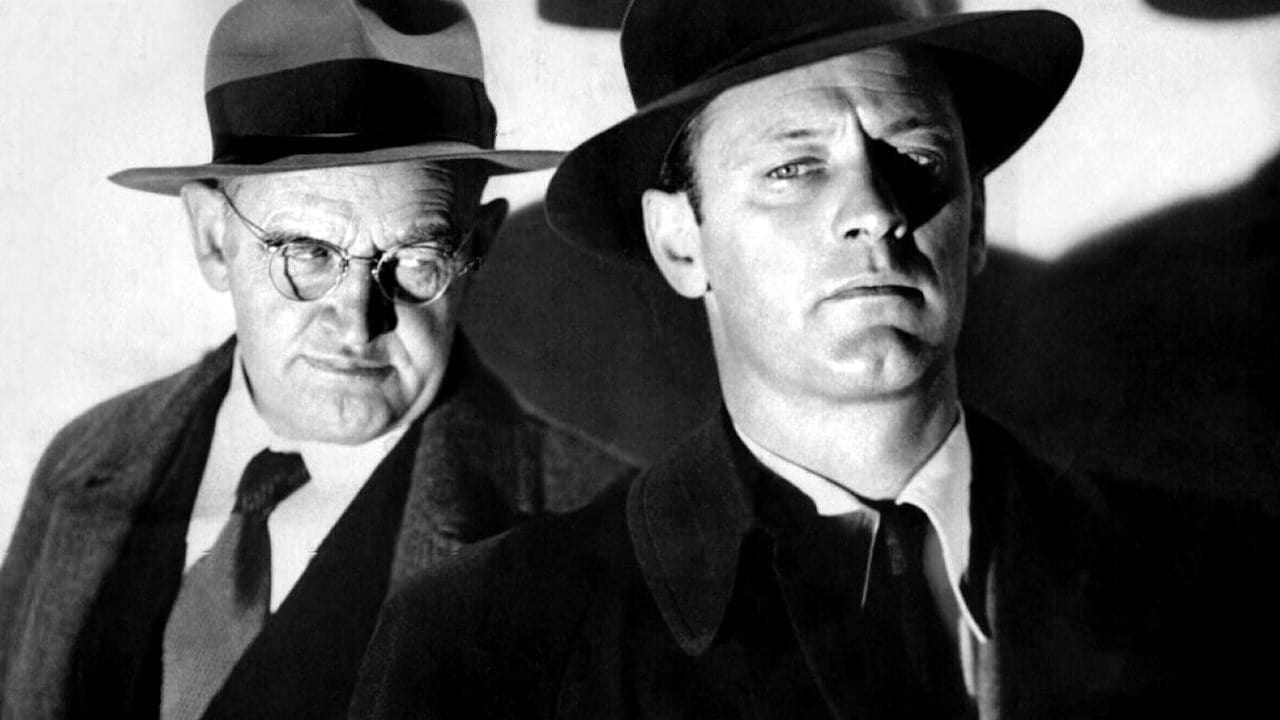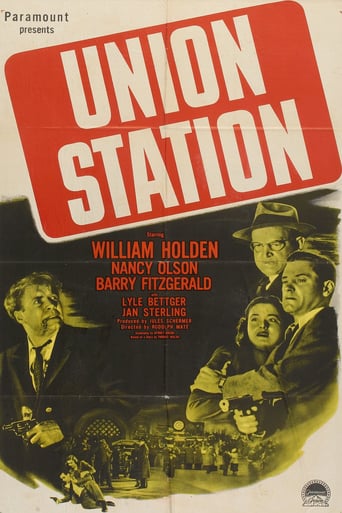

Not just a must-see for train buffs, this excitingly tense thriller will keep most audiences on the edges of their seats. And it even looks good and generates plenty of excitement on TV.William Holden and Nancy Olsen had just made a big hit in "Sunset Boulevard", so Paramount went all out to infuse taut entertainment qualities into "Union Station". They succeeded magnificently. The strong plot was forcefully put across with crisp dialogue, interesting characters, personable acting, a vivid setting, tight direction, atmospheric photography, sharp pacing and solid action. It all added up to gripping excitement, and absolutely cliffhanging suspense.
... View MoreUnion Station is directed by Rudolph Maté and written by Sydney Boehm and Thomas Walsh. It stars William Holden, Nancy Olsen, Barry Fitzgerald, Lyle Bettger, Jan Sterling and Herbert Heyes. Music is by Irvin Talbot and cinematography by Daniel Fapp.When a sharp-eyed woman spots a man with a gun on a train she alerts the railroad police. This is merely the start of the events that lead to the kidnapping of a blind heiress by a ruthless thug...A film of two excellent stages. The first two thirds of the movie is concerned with setting up the crime and fully introducing us to the key characters involved on both sides of the law. Relationships are formed or destroyed and as the railroad police work with the regular police, we the viewers get an in-depth look at the procedures involved in crime solving and averting panic in a busy rail station. Callous violence infiltrates the narrative, with deaths and threats the order of the day (the detectives as well as the perps are not beyond strong arm tactics here), and the bustling station and grimy stockyards locales are superbly utilised as backdrops to the drama.Then the last third arrives and we enter into the stark reality of the crime and mindset of kidnap leader Joe Beacon (Bettger). Dubious morality and the cheapness afforded life is pungent in the air, and then we shift locations underground to the municipal tunnels where Maté and Fapp use the unique settings for a clinically noir world of jeopardy and fret that builds to an exciting and suspense filled cat and mouse finale. The direction is smooth, the editing also seamless, while Holden, Olsen, Bettger and Fitzgerald lead off a roll call of enjoyable performances.Jan Sterling is short changed with a stereotyped character that doesn't get nearly enough screen time, while it's a bit of a stretch to accept the plausibility of Olsen's character's involvement in the unfolding investigation/manhunt. But small quibbles aside, Union Station is a tough, tense and often ruthless crime thriller that's constructed with great skill by the makers. 8/10
... View MoreUnion Station (1950)I saw "Sunset Blvd" right after seeing this one, and it really is pretty cool that the two leads here were in such different films. And with such ease. William Holden is the key actor in both cases--in the sense of screen time, of course, but also screen presence. But Nancy Olson as a kind of sweet stereotype is right on. Good stuff to build a movie around.Or the other way around. Certainly in both cases there is a core concept that the actors fit into. "Union Station" has, by way of its title right off the bat, a clean focus. Holden plays William Calhoun, head of security for a fairly large train station in an unnamed town. The crime almost doesn't matter--it's a kidnapping with ransom--because we never quite feel for the victims (hostage and hostage's family) so much as feel the investigation happen. And key there is an odd and believable clash (romantic clash) between Calhoun, who has to do his job, and Olson's character, who is a typical person who wants to do good but doesn't understand the cool machinations of police work.The first half of the movie is more interesting for its turns of plot. It leads us through the various stages of the discovering the crime and the nature of its extent without pushing. It's quite a nice insider look at the logic of it. Then the second half turns to more action--chasing and drama pure and simple, with some of the best low light shooting you can ask for. This is the era when studios are moving away from shooting on lots to finding locations to work in, and some of the scenes are fabulous. The stock yard chase toward the beginning is fabulous, and all the ventilation tunnel scenes at the end equally so. The station itself, which takes up the bulk of the movie, is interesting and nicely contained. This is a movie you can simply "watch" for its visual flow, and the sites. In fact, I did this twice, almost by accident, because I was tired in the first round and wanted to see what I missed. In terms of plot, nothing much shows up the second time around, but the editing and photography are really so fine you can watch it all twice no problem.Back to "Sunset Blvd." then--there is on some level no comparison between the two, as movies, even if there are lots of overlaps in time and cast. It's not just that Billy Wilder is a far more inventive and interesting director than Rudolph Mate, but the intentions were far bigger. "Union Station" is a formula picture. It's not even a film noir, but an action drama with low key light and vigorous photography. It's worth noticing that Mate is a photographer, and was director of photography for some seriously wonderful movies. And he has a handful of great films to his resume, too. So he attacked what must have been an obvious boilerplate movie and made it really really good. Check it out.
... View MoreParamount's UNION STATION (1950) is another memorable noir from Hollywood's golden past making its belated DVD debut. A gritty and compelling thriller it was adapted for the screen from the violent novel "Nightmare In Manhattan" by Thomas Walsh. Daniel L. Fapp's stark Black & White cinematography brought a great style to it with its shifting use of light and shadow and the genuine locations, especially in the bustling Union Station itself in Los Angeles, added a realistic look and feel to the whole thing.A girl (the resistible Nancy Olson) sees a man (Lyle Bettger) on a train wearing a gun under his jacket and immediately suspects him of being up to no good (how it never occurs to her that he could perhaps be a cop is conveniently glossed over). She however reports the matter to the conductor who in turn alerts railway cop William Calhoun (William Holden). It soon comes to light that the man with the gun and another have kidnapped a blind girl and are holding her hostage for a ransom of $100,000 from her well to do businessman father (Herbert Heyes). Things really hot up when Calhoun, with help from the city police headed by Inspector Donnelly (Barry Fitzgerald), stakeout Union Station - the nominated drop zone for the ransom. The picture ends with a climactic chase sequence as Holden pursues Bettger through a maze of dark tunnels underneath the station for the inevitable and exciting shootout.Performances are generally fine throughout. Holden is terrific in it but it is unusual to see him as a cop. He plays the part well but watching him you can't help thinking he is an actor of a much higher calibre than is called for here and deserving of classier and more artistically challenging parts such as his Acadamy Award winning role as Sefton in "Stalag 17" (1953) or his perfect Joe Gillis in "Sunset Boulevard" which he and his co-star here Olson would embark on right after UNION STATION. Also kicking around his thick Irish brogue again Barry Fitzgerald repeats his role, almost verbatim, from "The Naked City" (1948) the only difference being his name here is Donnelly instead of Muldoon. But there's little doubt the movie belongs to Lyle Bettger as the heartless and sadistic kidnapper. Beside Jack Elam has there ever been a meaner or nastier baddie in movies? Born in 1915 Bettger made a full career out of playing menacing characters. He had a sinister smirk and a scary glare that was positively unnerving. His first film was Barbara Stanwyck's "No Man Of Here Own" just before UNION STATION and with the exception of only one time playing the hero in "Carnival Story" (1954) he continued throughout a busy career to be every moviegoer's favourite baddie "you loved to hate". Lyle Bettger retired in 1979 and died in 2003 at the age of 88.Unusually there is no one composer credited with scoring the picture. But there are minor contributions from Heinz Reomheld and stock music from Victor Young and Hugo Friedhofor. There is a spirited main title over the credits which sounds very much to me like something the great Victor Young could have written. The score was compiled and supervised by Irvin Talbot.The DVD release is an impeccable transfer with sharp as a button images and smooth sound. Clearly they had access to a new print of the movie and it shows. But there are no extras - not even a trailer. But now for a word of caution! Watch out for the most ridiculous and irritating logo you are ever likely to see which comes at the start of the DVD from a crowd called Olive Films. This has to be some kind of gag! But after all is said and done you can be confident, this silly intro. does nothing to diminish the excellence of the movie which remains a timeless classic.
... View More